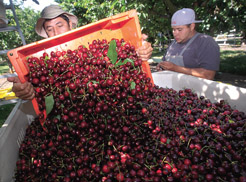
Weather affects local crop of third-highest grossing tree fruit
in San Benito County
Each year, the trees along Hwy. 25 change with the seasons.
Barren in fall, they start to leaf in late spring, with flower
blooms filling out in April and May, and eventually growing into
fruit.
Weather affects local crop of third-highest grossing tree fruit in San Benito County
Each year, the trees along Hwy. 25 change with the seasons. Barren in fall, they start to leaf in late spring, with flower blooms filling out in April and May, and eventually growing into fruit.
Between Hollister and Gilroy, George Rajkovich and his family have 225 acres of Bing cherry trees, and the fruit is the third-highest grossing tree crop in San Benito County, according to the 2008 annual crop report released in recent months.
“We have different varieties [of cherries],” Rajkovich said. “But the others are more pollinizers. We just market the Bing cherries.”
He started working with cherries in 1958, when he and his brother planted their first orchard. Each year, weather is the biggest factor that decides how well the crop does.
“Weather is our biggest challenge – weather and the market,” he said. “You can’t control the market either, but weather is our big enemy.”
When it comes to cherries, weather is everything. The fruit needs a certain amount of chilling hours each year to produce a heavy crop. But it also needs plenty of sunshine to sweeten the cherries, and cooler weather can slow the harvest while frosts damage the crop to top cherries in sales.
Farmers in Santa Clara County had a problem with an outbreak of cherry vinegar flies that did not cross the border to San Benito.
“This fruit fly did cause considerable damage in Santa Clara, and some counties in the Central Valley,” Coates said. “It was first observed in mid-May and has never been seen before. It is a brand new pest. In San Benito, we had the advantage of being a later ripening district and had the advantage of learning some of what happened in Santa Clara County.”
Local cherries are the last in the state to ripen, Coates said.
“We are essentially the last district to harvest in California and then from here it switches to Washington state,” Coates said. “If everything works out well, we have a marketing niche for a week or two where we have most of the cherries available on the West coast for one to two weeks.”
Harvesting starts in the southern San Joaquin Valley, then moves to the Northern San Joaquin Valley before switching to Santa Clara County, and then finally to San Benito County.
“There is a small window before the Washington cherries start,” George said.
The science of growing cherries
Most cherries, such as the local Bings, are self-sterile meaning that the male and female pollen on the trees cannot produce fruit. In order for Bing cherry orchards to be successful, orchardists plant a variety of other trees that have pollen that will fertilize the Bings.
Some of the varieties that can be used to pollinate Bings include black tartarian, Van, early Burlat, Utah giant and Rainiers.
“You need bees in a commercial cherry orchard,” said Bill Coates, the University of California extension farm advisor for San Benito, Santa Cruz, Santa Clara and Monterey counties, fruit and nut crops. “You don’t normally put bees in a apricot orchard … but cherries, like almonds, you need to bring in outside bees so you get enough pollination.”
Bees are brought in during March and April.
“Fortunately it is just after the end of the almond bloom,” Coates said. “They are transferred from almond orchards from the Central Valley over here to pollinate cherries.”
Cherry varieties
While Bings and Rainier cherries are the most commonly sold at local grocery stores and markets, there are dozens of cherry varieties that are broken into two main categories – guigne and bigarreaux.
The guigne, or gean, cherries have soft, tender flesh and the Bigarreaux cherries such as Bings and Rainiers, have a firm, crisp flesh. The soft flesh cherries are so rare at stores because they are harder to package and ship than their firmer-fleshed cousins.
Cherries are further divided into sweet and sour varieties. Sour cherries such as the early Richmond, Montmorency and Morello are often used in cooking for pies, preserves and relishes.









